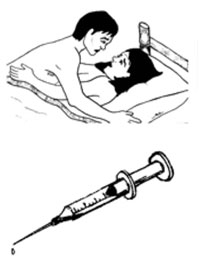25.1 General principles for preventing HIV infection
The goal of prevention in the context of HIV/AIDS is to avoid or minimise the risk of transmission of HIV from an infected person to an uninfected person. HIV prevention measures currently recommended at the individual and community levels are based on our knowledge of how HIV can be transmitted from person to person.
What are the modes of transmission of HIV?
Through sexual relations; through direct contact with contaminated blood; and from mother to child.

In this section, we will focus on prevention measures that individuals in a community should take in order to avoid HIV transmission through sexual relations and through direct contact with contaminated blood. In later study sessions, you will learn about how to protect yourself against HIV infection in the workplace (Study Session 26) and about specific preventative measures to reduce mother-to-child HIV transmission (Study Session 27).
Provider-initiated testing and counselling for HIV are also important preventative measures for HIV transmission (Study Session 24). Note that the measures described below are aimed at all individuals within a community, whether they know their HIV status or not. Specific issues concerning the prevention of HIV transmission from people living with HIV (PLHIV) to their partners will be discussed in more detail in Study Session 29.
Learning Outcomes for Study Session 25
